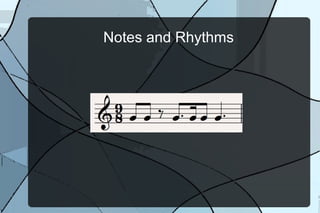Note values
•Download as ODP, PDF•
5 likes•3,681 views
Learning the different note names, their values and how to count basic rhythms.
Report
Share
Report
Share

Recommended
More Related Content
What's hot
What's hot (20)
THE BASIC RUDIMENTS OF MUSIC. An introduction to notation

THE BASIC RUDIMENTS OF MUSIC. An introduction to notation
Similar to Note values
Similar to Note values (8)
Grade 1 Music Theory Chapter 1- Note Values & Rhythms.pptx

Grade 1 Music Theory Chapter 1- Note Values & Rhythms.pptx
Art.MGMusic.CS2 powerPoint Slides Composition and Improv.pptx

Art.MGMusic.CS2 powerPoint Slides Composition and Improv.pptx
More from jimusik
More from jimusik (6)
Recently uploaded
https://app.box.com/s/7hlvjxjalkrik7fb082xx3jk7xd7liz3TỔNG ÔN TẬP THI VÀO LỚP 10 MÔN TIẾNG ANH NĂM HỌC 2023 - 2024 CÓ ĐÁP ÁN (NGỮ Â...

TỔNG ÔN TẬP THI VÀO LỚP 10 MÔN TIẾNG ANH NĂM HỌC 2023 - 2024 CÓ ĐÁP ÁN (NGỮ Â...Nguyen Thanh Tu Collection
Recently uploaded (20)
Sensory_Experience_and_Emotional_Resonance_in_Gabriel_Okaras_The_Piano_and_Th...

Sensory_Experience_and_Emotional_Resonance_in_Gabriel_Okaras_The_Piano_and_Th...
Plant propagation: Sexual and Asexual propapagation.pptx

Plant propagation: Sexual and Asexual propapagation.pptx
ICT Role in 21st Century Education & its Challenges.pptx

ICT Role in 21st Century Education & its Challenges.pptx
TỔNG ÔN TẬP THI VÀO LỚP 10 MÔN TIẾNG ANH NĂM HỌC 2023 - 2024 CÓ ĐÁP ÁN (NGỮ Â...

TỔNG ÔN TẬP THI VÀO LỚP 10 MÔN TIẾNG ANH NĂM HỌC 2023 - 2024 CÓ ĐÁP ÁN (NGỮ Â...
Food safety_Challenges food safety laboratories_.pdf

Food safety_Challenges food safety laboratories_.pdf
Salient Features of India constitution especially power and functions

Salient Features of India constitution especially power and functions
Exploring_the_Narrative_Style_of_Amitav_Ghoshs_Gun_Island.pptx

Exploring_the_Narrative_Style_of_Amitav_Ghoshs_Gun_Island.pptx
Interdisciplinary_Insights_Data_Collection_Methods.pptx

Interdisciplinary_Insights_Data_Collection_Methods.pptx
HMCS Max Bernays Pre-Deployment Brief (May 2024).pptx

HMCS Max Bernays Pre-Deployment Brief (May 2024).pptx
Note values
- 2. Notes and Rhythmic Value ● If you've been playing along you know that music notation is time and pitch Pitch Time
- 3. Time Signature ● You also know that time signatures indicate how many beats we count in a measure and what note value gets the beat.
- 4. Naming Convention – Quarter Note ● We name notes based on how much time they take up ● Since common time is 4/4 we can think of it like a pie ● Divide it into 4 pieces and you get “quarters” ● It then takes 4 “Quarter Notes” to fill the pie
- 5. Naming Convention – Half Note ● If we have something that takes 2 notes to fill the pie, it takes up half the pie ● We call this the “Half Note”
- 6. Naming Convention – Whole Note ● Continuing with our structure, something that last all four beats in common time takes up the whole pie ● We call this then the “Whole Note”
- 7. Naming Convention – Eighth Note ● The same is true for the opposite direction ● If we continue to divide the pie from quarter notes, we get eighths ● It takes 8 “Eighth Notes” fill a measure
- 8. Naming Convention – Sixteenth Note ● We can keep dividing and adding “flags” to the note head but each time, we double the previous division ● It takes 16 “Sixteenth Notes” notes to fill a pie
- 9. Beats ● Another way to consider notes is how many beats they get ● Here is a diagram of the note heads and their equivalent beats ● The Sixteenth Note would be ¼ of the beat ● A 32nd Note would be 1/8 of a beat
- 11. Doing the Math ● When it comes down to it, reading rhythm is simply learning how to divide time into the corresponding note values
- 12. Doing the Math ● In common time 4/4 you know that there should be 4 quarter notes in each measure ● We use this to know how far to count 1 2 3 4 1 2 3 4 1 2 3 4
- 13. Doing the Math ● For longer notes we simply connect the numbers (or drop them) ● We will use a – to show the connection 1 2 - 3 4 1 - 2 - 3 - 4 1 2 3 4
- 14. Doing the Math ● We know that quarters get full numeric values, 1, 2, 3, 4. ● Eighth notes are ½ a beat so we add “and” after the beat number (i.e. 4 &) 1 2 - 3 4 & 1 - 2 - 3 - 4 1 2 & 3 4 &
- 15. Doing the Math ● Sixteenth Notes are ¼ a beat so we need 4 syllables to be able to speak them ● We have & already so we add “e” and “a” 1 2 - 3 4 & 1 - 2 - 3 - 4 1 2 e & a 3 a 4 &
- 16. Doing the Math ● No matter what, the beats always land in the same place ● Being able to speak these rhythms takes practice ● Try to read the line below in tempo (start slowly) 1 2 - 3 4 & 1 - 2 - 3 - 4 1 2 e & a 3 a 4 &